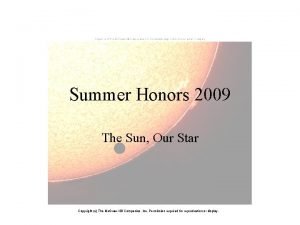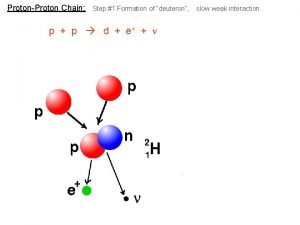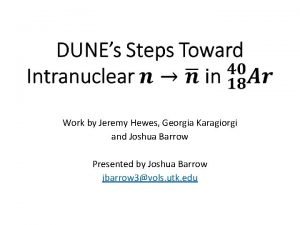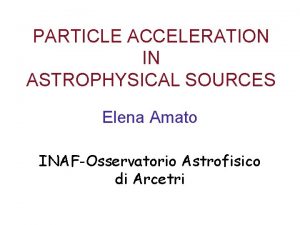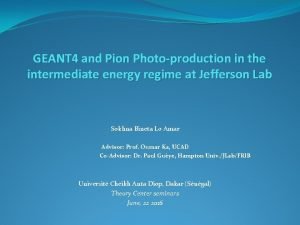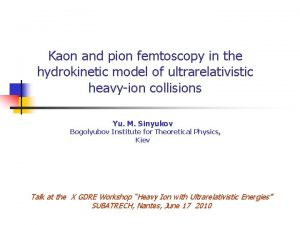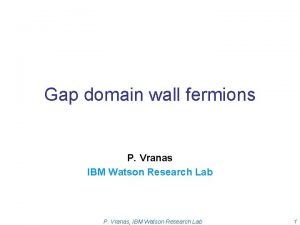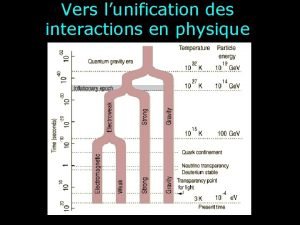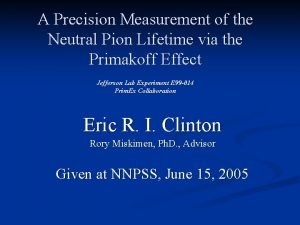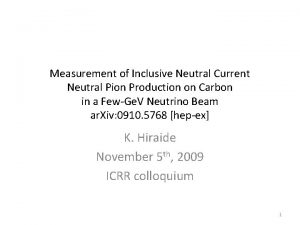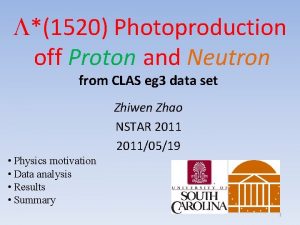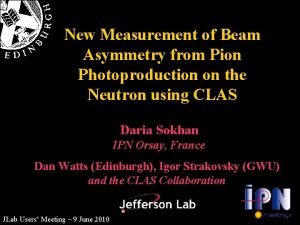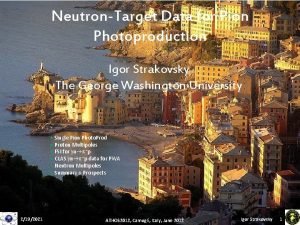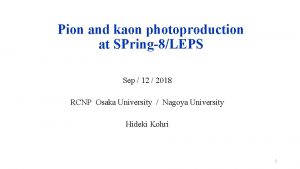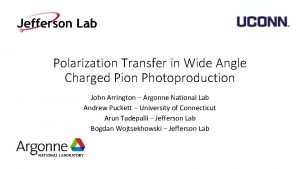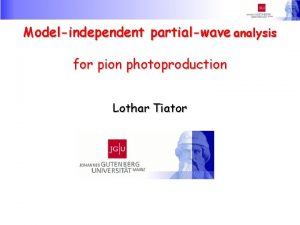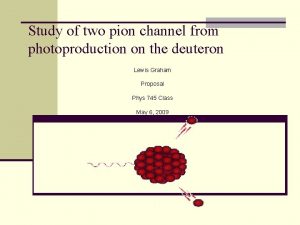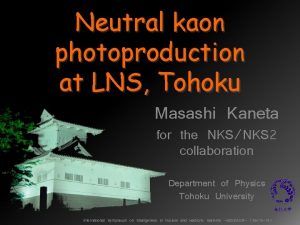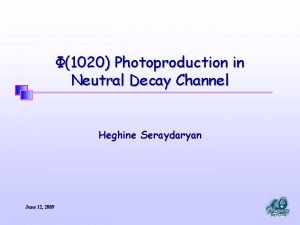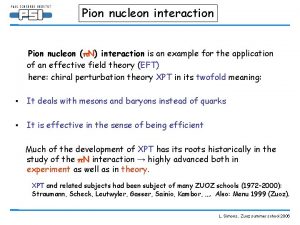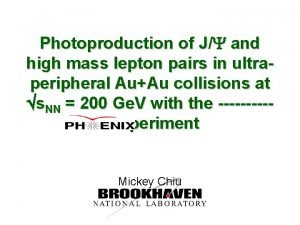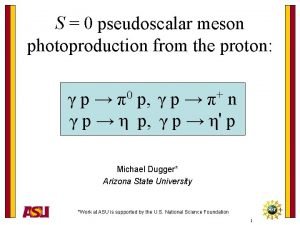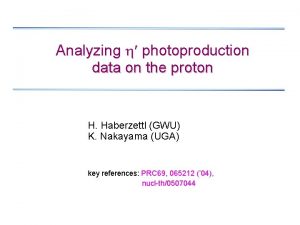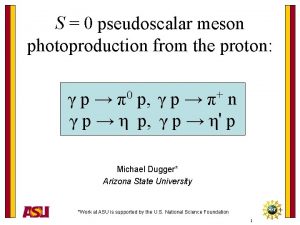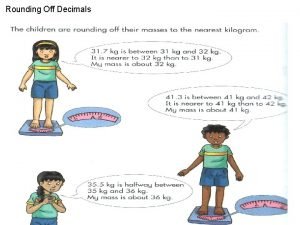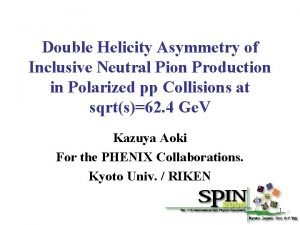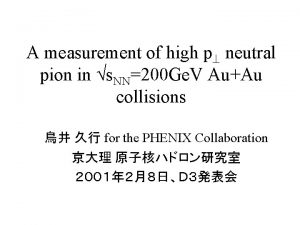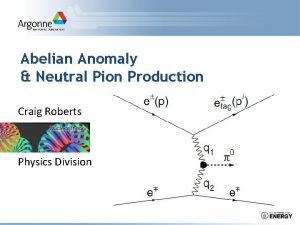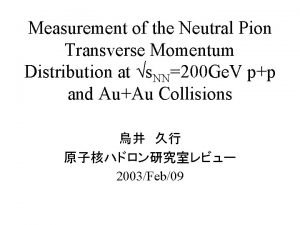Photoproduction of neutral pion pairs off the proton
























- Slides: 24

Photoproduction of neutral pion pairs off the proton with the Crystal-Barrel-Detector at ELSA Michael Fuchs October 14 th, 2005

Introduction ◦ Experiment ◦ Selection ◦ Acceptance ◦ Results ◦ Summary ➢ Introduction ➢ Experiment ➢ Selection ➢ Acceptance ➢ ➢ ➢ Problems ➢ “Alternative” method Results ➢ Total cross section ➢ Differential cross sections ➢ Dalitz-Plots Summary and Outlook

Introduction ◦ Experiment ◦ Selection ◦ Acceptance ◦ Results ◦ Summary Missing resonances Nucleon resonances Löring, et. al. EPJA 10, 309 -346 (2001)

Introduction ◦ Experiment ◦ Selection ◦ Acceptance ◦ Results ◦ Summary Crystal-Barrel@ELSA Setup ➢ ➢ Tagging System ➢ Crystal Barrel ➢ Energy: incoming ➢ Energy, direction: decay ➢ Range: 25 – 95 % of Ee- ➢ 1380 Cs. I(Tl) crystals ➢ Covers 98% of 4 Inner Detector ➢ Charged particle ident.

Introduction ◦ Experiment ◦ ➢ Selection ◦ Acceptance ◦ Results ◦ Summary Cuts on reconstructed information ➢ Tagging System ➢ ➢ Inner detector ➢ ➢ At least: 2 of 3 layers → Charged Particle Crystal-Barrel ➢ ➢ Coincident hit in MWPC and Scintillator 4 or 5 PEDs Invariant masses ➢ Two invariant masses of two photons: m( ) in interval: 134. 97 ± 16. 00 Me. V

Introduction ◦ Experiment ◦ ➢ Selection ◦ Acceptance ◦ Results ◦ Summary Cuts on kinematic fit ➢ E, p conservation ➢ ➢ Confidence Level (PS) >1% Final Cuts ➢ CL ( p → p 0 0) > 10% ➢ Matching Protons: (p. Inner & pkin. Fit) ➢ CL ( p → p 0 0) > CL ( p → p 0 ) Invariant p 0 -mass (@ 3. 2 Ge. V) ➢ Decay of baryon resonances in: ➢ (1232) ➢ D 13 (1520) ➢ X (1660)

Introduction ◦ Experiment ◦ Selection ◦ Acceptance ◦ Results ◦ Summary Dalitzplots: m 2 (p 0) vs m 2 (p 0) 1800 < √s < 2000 Me. V 2000 < √s < 2200 Me. V Clear bandlike structures in Dalitzplot ↓ Cascading decays of baryon resonances

Introduction ◦ Experiment ◦ Selection ◦ ➢ Problems: ➢ Areas with missing Acceptance ➢ ➢ Acceptance ◦ Results ◦ Summary Extrapolation necessary MC events ➢ Distribution by phase space ➢ Dynamics of reaction not included 3 particle final states ➢ 5 independent variables ➢ Automatic Integration Solution: ➢ Use MC-events with correct reaction dynamics

Introduction ◦ Experiment ◦ Selection ◦ ➢ Weighting procedure ➢ Preparation ➢ Use ➢ ➢ Original distr. (PS-MC) Target distr. (Correct dynamics) Create ➢ Normalized weights: wnorm Copy ➢ ➢ ➢ Original distribution (yellow) Target distribution (orange) By event Generate random number: r If: wnorm < r ➢ ➢ Acceptance ◦ Results ◦ Summary Copy whole event in new dataset Next Step: ➢ Weight factors using PWA Normalized weights: wnorm

Introduction ◦ Experiment ◦ Selection ◦ ➢ Acceptance ◦ Results ◦ Summary Partial wave analysis ➢ Determination of resonance properties ➢ ➢ Masses Partial widths Coupling constants Version by A. Sarantsev, U. Thoma et. al. ➢ ➢ ➢ Isobar - model Breit-Wigner (or K-Matrix) parametrization Unbinned Maximum-Likelihood fit ➢ ➢ Event based All correlations correctly taken into account (5 independent variables) No fitting of projections !!

Introduction ◦ Experiment ◦ Selection ◦ Acceptance ◦ Results ◦ Summary Comparison of Acceptance: Phasespace MC PWA weighted MC

Introduction ◦ Experiment ◦ Selection ◦ Acceptance ◦ Total Cross Section Results ◦ Summary

Introduction ◦ Experiment ◦ Selection ◦ Acceptance ◦ Results ◦ Summary 1350 < √s < 1570 Me. V (1232) 1570 < √s < 1800 Me. V (1232) 1800 < √s < 2060 Me. V D 13(1520) 2060 < √s < 2550 Me. V Differential Cross Section: m(p 0) X(1660)

Introduction ◦ Experiment ◦ Selection ◦ Acceptance ◦ Results ◦ Summary 1350 < √s < 1570 Me. V 1570 < √s < 1800 Me. V 1800 < √s < 2060 Me. V 2060 < √s < 2550 Me. V Differential Cross Section: m( 0 0) f 0(980)

Introduction ◦ Experiment ◦ Selection ◦ Acceptance ◦ Results ◦ Summary Dalitzplot m 2 (p 0) vs m 2 (p 0)

Introduction ◦ Experiment ◦ Selection ◦ Acceptance ◦ Results ◦ ➢ Selection ➢ ➢ MC contains correct dynamics of reaction Cross Sections ➢ ➢ Good identification of: p→p 0 0 Acceptance ➢ ➢ Total and differential cross sections up to E ~ 3 Ge. V Data used for Partial Wave Analysis ➢ Search for new baryon resonances ➢ Determination of resonance properties: ➢ ➢ Summary Masses, Partial widths, Coupling constants Cascading decays of baryon resonances observed via ➢ (1232) D 13(1520) X(1660)

Introduction ◦ Experiment ◦ Selection ◦ Acceptance ◦ Results ◦ ➢ Summary Acknowledgements The Crystal-Barrel Collaboration ➢ U. Thoma ➢ E. Klempt ➢ A. Sarantsev Thank you for your attention!

Introduction ◦ Experiment ◦ Selection ◦ Acceptance ◦ Results ◦ Summary ◦ Gen MC Rec MC Add-Ons Acceptance (Phase space) 4 Vec: p, 0 E , ID PWA ID, wnorm< r r Rndm() Gen MC No Yes Copy Rek MC Acceptance (PWA weighted)

Introduction ◦ Experiment ◦ Selection ◦ Acceptance ◦ Results ◦ Summary ◦ Total cross section @ 1. 4 Ge. V Add-Ons

Introduction ◦ Experiment ◦ Selection ◦ Acceptance ◦ Results ◦ Summary ◦ Total cross section @ 3. 2 Ge. V Add-Ons

Introduction ◦ Experiment ◦ Selection ◦ Acceptance ◦ Results ◦ Summary ◦ Differential Cross Section Add-Ons

Introduction ◦ Experiment ◦ Selection ◦ Acceptance ◦ Results ◦ Summary ◦ Add-Ons Differential cross section: m(p 0) for selected energie bins in E

Introduction ◦ Experiment ◦ Selection ◦ Acceptance ◦ Results ◦ Summary ◦ Add-Ons Differential cross section: m( 0 0) for selected energie bins in E

Introduction ◦ Experiment ◦ Selection ◦ Acceptance ◦ Results ◦ Summary ◦ Dalitzplot m 2 (p 0) vs m 2 ( 0 0) Add-Ons
 Proton proton chain
Proton proton chain Fission definition
Fission definition Proton proton chain
Proton proton chain Georgia karagiorgi
Georgia karagiorgi Pion decay
Pion decay Pion geant
Pion geant Pion
Pion Gdwf
Gdwf Louis pion montre
Louis pion montre Pion lifetime
Pion lifetime Vsepr theory
Vsepr theory Elbows off the table fingers off the food song
Elbows off the table fingers off the food song Làm thế nào để 102-1=99
Làm thế nào để 102-1=99 Chúa yêu trần thế
Chúa yêu trần thế Sự nuôi và dạy con của hươu
Sự nuôi và dạy con của hươu đại từ thay thế
đại từ thay thế Quá trình desamine hóa có thể tạo ra
Quá trình desamine hóa có thể tạo ra Vẽ hình chiếu vuông góc của vật thể sau
Vẽ hình chiếu vuông góc của vật thể sau Cong thức tính động năng
Cong thức tính động năng Tỉ lệ cơ thể trẻ em
Tỉ lệ cơ thể trẻ em Thế nào là mạng điện lắp đặt kiểu nổi
Thế nào là mạng điện lắp đặt kiểu nổi Các loại đột biến cấu trúc nhiễm sắc thể
Các loại đột biến cấu trúc nhiễm sắc thể Lời thề hippocrates
Lời thề hippocrates Vẽ hình chiếu đứng bằng cạnh của vật thể
Vẽ hình chiếu đứng bằng cạnh của vật thể Bổ thể
Bổ thể
